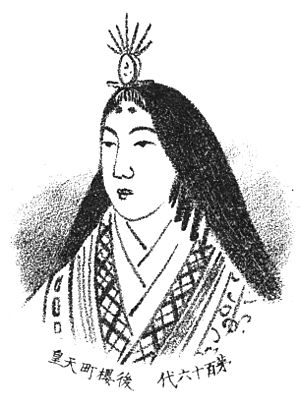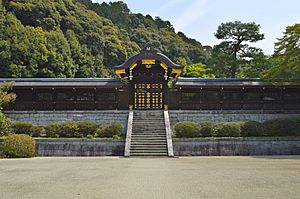Empress Go-Sakuramachi facts for kids
Quick facts for kids Empress Go-Sakuramachi後桜町天皇 |
|
|---|---|
 |
|
| Empress of Japan | |
| Reign | 15 September 1762 – 9 January 1771 |
| Coronation | 31 December 1763 |
| Predecessor | Momozono |
| Successor | Go-Momozono |
| Shōgun | Tokugawa Ieharu |
| Born | Toshiko (智子) 23 September 1740 |
| Died | 24 December 1813 (aged 73) |
| Burial | Tsuki no wa no misasagi, Kyoto |
| House | Yamato |
| Father | Emperor Sakuramachi |
| Mother | Nijō Ieko |
| Signature |  |
Empress Go-Sakuramachi (後桜町天皇, Go-Sakuramachi-tennō, 23 September 1740 – 24 December 1813) was the 117th ruler of Japan. She was named after her father, Emperor Sakuramachi. The word go- (後) in her name means "later" or "second one." She ruled from 1762 until she stepped down in 1771. During her rule, there was a secret plan to give power back to the Emperor instead of the Shogun. But this plan did not succeed.
Empress Go-Sakuramachi and her brother, Emperor Momozono, were the last direct descendants of Emperor Nakamikado. Her nephew, Emperor Go-Momozono, became Emperor after she stepped down in 1771. Go-Momozono became very sick and died eight years later. He had no children to take his place. To avoid a big problem about who would rule next, Go-Momozono quickly adopted a new heir. This happened just before he died, because his aunt insisted. In her later years, Go-Sakuramachi became a "guardian" to the adopted heir, Emperor Kōkaku. She guided him until her death in 1813. Go-Sakuramachi was the last of eight women to rule Japan as an Empress.
Contents
Empress Go-Sakuramachi's Life Story
Her Early Life
Before Princess Toshiko became Empress, her personal name was Toshiko (智子). She was born into the Imperial family on September 23, 1740. Toshiko was the second daughter of Emperor Sakuramachi. Her mother was Nijō Ieko.
Toshiko had an older sister who died young. She also had a brother named Toohito. He became Emperor Momozono when their father died in 1747. Empress Go-Sakuramachi and her brother were the last direct descendants of Emperor Nakamikado. Toshiko's family lived in the dairi of the Heian Palace. Her first title was Isa-no-miya (以茶宮). Later, it changed to Ake-no-miya (緋宮).
Her Time as Empress
On September 15, 1762, Princess Toshiko became Empress. Her brother, Emperor Momozono, stepped down from the throne for her. Momozono's son, Prince Hidehito (who later became Emperor Go-Momozono), was only 5 years old. Everyone expected his aunt, Empress Go-Sakuramachi, to rule until her nephew was old enough.
Even though she was called "Empress," her power was mostly symbolic. The shoguns of the Tokugawa family truly controlled Japan. There was one important event during her rule in 1766. This was an unsuccessful plan to take power away from the shogunate and give it back to the Emperor. This attempt failed. However, more challenges to the shogun's power would happen later, during the rule of Emperor Kōkaku.
Other events during Go-Sakuramachi's reign included the start of a merchant group. This group sold Korean ginseng in the Kanda area of Edo. In 1770, a large comet (Lexell's Comet) with a very long tail appeared in the night sky. It was visible throughout the summer and autumn. That same year, two major disasters happened. A typhoon destroyed the new Imperial Palace in Kyoto. Also, a long drought began, which lasted for 15 years. Go-Sakuramachi stepped down on January 9, 1771. Her nephew, Hidehito, became the new Emperor.
After Stepping Down
After stepping down, Go-Sakuramachi became a Daijō-tennō, which means a Retired Empress. But her nephew's rule as Emperor did not last long. Emperor Go-Momozono became very sick in 1779. He had no children, which caused a big problem about who would rule next. This is called a succession crisis.
Go-Sakuramachi talked with important court officials and guards. She first planned to adopt Prince Sadayoshi as an heir. But instead, they chose Prince Morohito. He was from the Kanin branch of the Imperial family. Prince Morohito was the sixth son of Prince Kan'in-no-miya Sukehito. The Emperor's chief advisor also supported him. Go-Momozono quickly adopted Prince Morohito. He then became Emperor Kōkaku when Go-Momozono died.
After the throne went to this new branch of the Imperial family, Go-Sakuramachi was called the "Guardian of the Young Lord." This referred to the new Emperor. A major event before her death happened in 1789. She scolded Emperor Kōkaku for a problem involving his father's special title. Former Empress Go-Sakuramachi died on December 24, 1813, at 73 years old.
Go-Sakuramachi's spirit, or kami, is honored at the Imperial tomb called Tsuki no wa no misasagi. This tomb is located at Sennyū-ji in Higashiyama-ku, Kyoto. Many other Emperors and Empresses are also honored there.
Her Lasting Impact
Go-Sakuramachi was the last of eight women to rule Japan as an Empress. She also wrote a book called Matters of Years in the Imperial Court (禁中年中の事, Kinchū-nenjū no koto). This book contains poems, letters from the Emperor, and records of Imperial events.
Even though seven other women ruled as empresses, their successors were almost always male. This is why experts believe these female reigns were temporary. They argue that the tradition of only male rulers should continue. The only time a daughter followed her mother on the throne was when Empress Genmei was followed by her daughter, Empress Genshō. Other women who ruled as empresses with male heirs include: Empress Suiko, Empress Kōgyoku (also known as Saimei), Empress Jitō, Empress Kōken (also known as Shōtoku), and Empress Meishō. The discussion about changing succession laws to allow a future Empress continues today.
Eras and Important Officials
The years of Go-Sakuramachi's rule are known by different era names or nengō. These eras help historians keep track of time.
The eras during Go-Sakuramachi's reign were:
During her reign, a group of very powerful men called the Kugyō (公卿) served the Emperor. Even when the Emperor's power was not very strong outside the palace, this group of officials still existed. This elite group usually had only three or four men at a time. They were hereditary courtiers, meaning their families had held these positions for a long time.
This top group of officials included:
- Sadaijin (Minister of the Left)
- Udaijin (Minister of the Right)
- Naidaijin (Minister of the Center)
- Dainagon (Chief Counselor of State)
See also
 In Spanish: Go-Sakuramachi Tennō para niños
In Spanish: Go-Sakuramachi Tennō para niños


